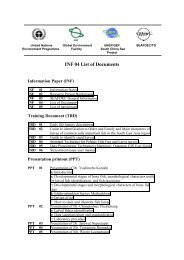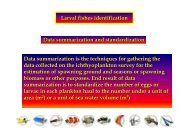TRD 05: Data Presentation techniques (Mapping) Quantum GIS ...
TRD 05: Data Presentation techniques (Mapping) Quantum GIS ...
TRD 05: Data Presentation techniques (Mapping) Quantum GIS ...
Create successful ePaper yourself
Turn your PDF publications into a flip-book with our unique Google optimized e-Paper software.
4.1 ESRI Shapefiles<br />
You can also select the Encoding type for the shapefile if desired.<br />
Figure 3: Open OGR <strong>Data</strong> Source Dialog<br />
Selecting a shapefile from the list and clicking OK loads it into Q<strong>GIS</strong>. Figure 4 shows Q<strong>GIS</strong> after<br />
loading the country.shp file.<br />
Tip 4 LAYER COLORS<br />
When you add a layer to the map, it is assigned a random color. When adding more than one layer at a time,<br />
different colors are assigned to each.<br />
Once loaded, you can zoom around the shapefile using the map navigation tools. To change the<br />
symbology of a layer, open the layer properties dialog by double clicking on the layer name or by<br />
right-clicking on the name in the legend and choosing Properties from the popup menu. See Section<br />
4.3.1 for more information on setting symbology of vector layers.<br />
4.1.2. Improving Performance<br />
To improve the performance of drawing a shapefile, you can create a spatial index. A spatial index<br />
will improve the speed of both zooming and panning. Spatial indexes used by Q<strong>GIS</strong> have a .qix<br />
extension.<br />
Use these steps to create the index:<br />
Q<strong>GIS</strong> 0.8 User Guide 19
















